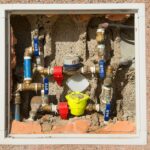Many homeowners and business owners rely on a sump pump to keep water out of their basements in a storm. Without the proper maintenance, however, a sump pump may fail right when you need it. Simple preventative maintenance could save you the cost of cleaning up a flooded basement.
Without maintenance, a sump pump may fail. Use these tips to keep your sump pump in good condition and ready for the next storm.
6 Tips to Keep Your Sump Pump in Good Condition
Use the following tips to help keep your sump pump in good condition so you’ll be ready for the next storm.
Test the Sump Pump
Test the pump every year before the “wet season” in early spring to ensure it will effectively function when needed. To test the pump, slowly pour a bucket of water into the sump pump. If the pump doesn’t turn on once the water level reaches a predetermined level or does not properly discharge the water, it may be broken or clogged. In such cases, call a licensed plumber for assistance.
Clean the Pump
Unplug the unit. Then, remove the pump’s lid (if it has one) and use a flashlight to check inside. Remove any dirt, sand, gravel, or other debris from the pump opening. If the incoming drainage lines are blocked, it becomes difficult for water to channel into the sump pit. Keeping the pump clean ensures efficient operation and extends its lifespan.
Check for Worn Parts
A sump pump’s moving parts can wear out over time, preventing the pump from operating during a flood. The float switch is the most common part that fails, and many manufacturers recommend replacing the float every two years. Also, check for corrosion and clean the inlet screen, which appears at the pump’s base.
Regular inspections can prevent unexpected failures.
Install a Battery Backup
A battery backup will help ensure your pump doesn’t fail, even in the event of a power outage. If you have a battery backup installed, make sure to test the battery by unplugging the pump to see if it kicks in. This extra layer of protection can be crucial during severe weather when power outages are more likely.
Inspect the Water Discharge Area
Ensure water is directed at least 20 feet away from your house and that it is flowing freely and not clogging the line. Proper discharge prevents water from seeping back into your basement and causing further issues.
Signs Your Sump Pump Needs Repair or Replacement
Your sump pump will display some distinct characteristics if it needs to be repaired or replaced. Contact a professional if you encounter any of these signs:
- Aging: Experts recommend replacing an average-use unit every 7-10 years. If your pump runs frequently, its lifespan ranges from 5-7 years.
- Odors: Rotten or moldy smells from your basement may indicate a sump pump malfunction.
- Rust: An older pump’s construction may not have rust-resistant materials. A pump with rust that you can’t scrub away needs to be replaced or repaired.
- Noises: Sump pumps shouldn’t generate loud noises. If your pump is making unusual noises like humming, clanging, or banging, it could be time for a replacement.
- Water: The most noticeable sign your sump pump needs repair or replacement is the presence of water in your basement. If there is water, the pump isn’t doing its job.
Trust Oriole Basement Waterproofing for Your Sump Pump Needs
At Oriole Basement Waterproofing, we understand the importance of a properly functioning sump pump in protecting your home from water damage. With over 70 years of experience, we offer comprehensive sump pump maintenance, repair, and replacement services to keep your basement dry and safe.
Don’t wait until it’s too late. Contact Oriole Basement Waterproofing today for a free estimate and ensure your sump pump is ready for the next storm. Call us at (410) 879-3360 for Maryland or (717) 750-9100 for Pennsylvania, or visit our website at oriolebw.com to learn more and schedule your maintenance check.






